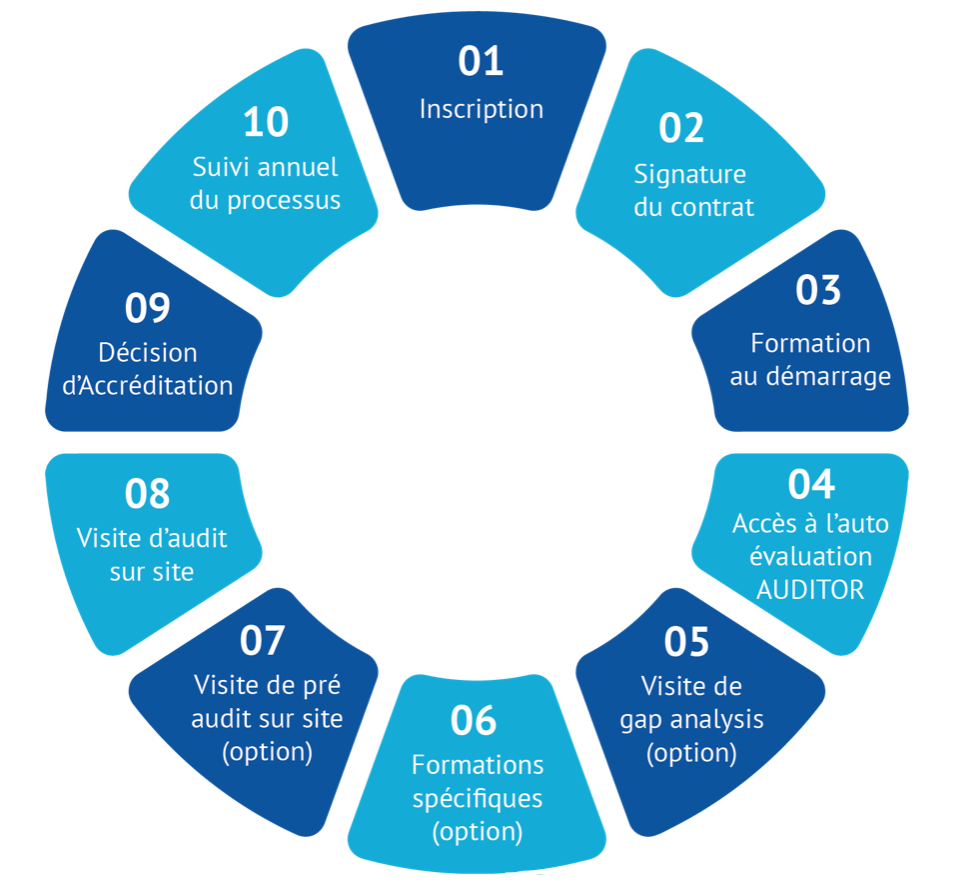The 10 steps to accreditation
The 10 steps to accreditation

01.
Registration
On this site you will find a registration form. An advisor will then call you if more information is needed. Within a week, you will receive a detailed offer with a cooperation agreement. The advisor will remain at your disposal if you have any further questions. This advisor will remain your dedicated administrative point of contact throughout the accreditation process.
02.
Signing the contract
The signing of the contract opens the accreditation process.
03.
Start-up training
Within a month of signing the contract, and provided that the accreditation team has already been set up within the institution, our team of trainers will present the basics of the accreditation process. The institution chooses the staff members concerned (management, accreditation team, executives, middle management, etc.). This training lasts one day per group of 20 participants.
04.
Access to the Auditor self-assessment tool
At the same time, the institution has access to its dedicated evaluation tool. The accreditation process enters its most concrete phase. At the same time, those responsible for the institution's accreditation team can get in touch with our experts in the various fields, who will answer all their questions.

05.
Visit to gap analysis (optional)
The gap analysis visit by our experts allows the institution to see what level of good practice it already has in place. Following this visit, the institution will see in which areas it needs to put particular emphasis in order to succeed in the accreditation process. Depending on the level already implemented, the experts can advise the institution on the level of accreditation it could achieve.

06.
Specific training and advice (optional)
A few weeks or months into the process, the institution may notice that it has some gaps in certain areas. At this stage, they can call on our accredited partners who will be able to offer them specific training or advice in the different areas of accreditation. We have a team of doctors, pharmacists, nurses, nutritionists, logisticians, quality experts (non exhaustive list) at your disposal. For training, most institutions call on our partners for training in management, change management, patient reception, ....

07.
On-site pre-audit visit (optional)
Depending on the size of the institution, after 18 months (e.g. certification programme or MR-MRS institutions) to 24 months (hospitals and clinics), a pre-audit visit can be organised on site. This pre-audit visit, similar in form to the final visit, allows the teams to familiarise themselves with an audit visit and to see how far they still have to go. This optional visit is carried out by EuroMedi International auditors, different from those of the final audit, which usually takes place within six months.
08.
On-site audit visit
When the school feels ready, it notifies EuroMedi International. Within two months, EuroMedi auditors visit the facility. The size of the team varies depending on whether it is an accreditation or a certification, a general hospital or a smaller facility. Again, depending on the size of the institution, the accreditation visit lasts from two days to a full week. During the visit, the auditors will interview members of the management, staff and visit the whole institution. They will also interview patients and residents, if they agree. At the end of the visit, a first debriefing is made to the management. The final audit report is sent within a month.
09.
Accreditation Decision
The accreditation or certification decision is based on the data collected
⦁ During the audit visit
⦁ Through the analysis of different documents (procedures, regulations, internal evaluations, evidence of training,...) which will be sent by the institution to EuroMedi at its request
⦁ By analysing patient or resident assessments via a dedicated digital tool.
About one month after the audit visit the institution receives the audit report with the decision of the auditors.
There are three possible solutions:
1. The institution is accredited and is invited to continue its efforts in terms of quality. It renews this accreditation within two years. At that point, it either maintains its level or moves to a higher level of accreditation.
2. The institution is conditionally accredited and then has 6 months to comply with the remarks made by the auditors in the report. Depending on the situation, a submission of documents proving compliance may be sufficient. In other cases, a new visit will be necessary.
3. The institution is not accredited because there are serious shortcomings identified during the analysis of the information collected. The establishment will have 12 to 24 months to comply before the second audit visit.
10.
Monitoring the process
Accreditation is not just a one-off audit visit, but a process of continuous improvement. The aim of accreditation is to ensure that good practice is implemented over the long term and that further improvements are also made. This is why the institution is invited, at the end of the first accreditation cycle, to renew the process by continuing at the same level or aiming for a higher level. There are 4 levels of accreditation.
